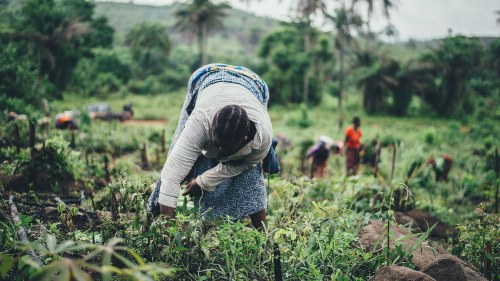How Data Addresses Food Insecurity Challenges in a Rapidly Urbanizing Africa

Precise, timely, and trustworthy data can help achieve food security within African cities.
Rewinding two decades to my upbringing in an African city, a vivid memory of an urban home lingers in my mind. It is a mental picture that epitomizes a typical African home in the city. I recall a sight where in the commonest instances, homes had at least a permutation of pawpaw, guava, lemon, or avocado pear trees. Often, this image extends to encompass backyard gardens, and spaces where families cultivated vegetables, herbs, and even kept small livestock like chickens, rabbits, and ducks. Some households derived their livelihoods from these domestic farming ventures, evident from signs boldly proclaiming "chickens are sold here" decorating fences and gateways. Back in the day, land for agriculture was relatively available for families within the cities such that farming during school holidays was the norm amongst most African children.
Nowadays, these are becoming rare sights. The modern urban landscape has shifted, with most homes having limited spaces for a backyard garden, let alone a livestock kraal. What’s left is just small spaces with concrete parking lots to accommodate a car or two and a few flowering shrubs here and there. These days, land for agriculture within city limits has diminished, prompting the transformation of farming into a rural endeavor—a shift many families find financially burdensome due to associated expenses like transportation and accommodation.
In the wake of exponential population growth within African cities, the charming customs of home-based farming have evolved into tales of the past. The urban populace now confronts the necessity of purchasing their own food. With the rising cost of living in cities and growing urban poverty, the question of whether people can afford adequate, safe, and nutritious food hangs in the balance.
The Urban Strategy put forth by the World Food Programme reflects the ongoing global trend of urbanization, with 55 percent of the world's population currently residing in urban spaces. Projections estimate a further increase of 2.3 billion urban dwellers by 2050, predominantly in Africa. This transformation is one that many have personally witnessed. Unfortunately, increased urbanization has been accompanied by food insecurity and malnutrition emanating from dwindling of farming land in the cities, growing urban poverty and inequalities, among other factors.
At this juncture, the issue of food insecurity in cities is uncontestable. Precise, timely, and trustworthy data stands as a cornerstone in comprehending the enormity of the problem. Thus, six pivotal roles delineate how data can steer the journey towards achieving food security within African cities.
1. Quantifying the Problem, Baselining, and Tracking Progress/Change
Impactful solutions for addressing food insecurity issues in African urban areas hinges upon the availability of accurate and reliable data on the extent of the food insecurity problem. This data not only needs to encompass the physical availability of food, but demands current insights into malnutrition prevalence and the accessibility to affordable and nutritious food. For example, data regarding urbanization trends can provide understandings into the trajectories and pace of urban expansion, thereby revealing potential hotspots requiring assistance. By virtue of its comprehensive nature, this data can serve as both a baseline for initial assessments and a compass for defining targets and indicators that underpin the measuring of advancements in food security interventions.
2. Steering Policy, Decisions, and Governance
According to the Africa data revolution report 2020, data scarcity impedes decision making and governance in most sectors including agriculture, health, and nutrition within the African context. The prevailing data landscape often comprises outdated, inconsistent, and inaccurate information, thus hampering the formulation of informed policies and guiding decisions. For instance, a cloud of uncertainty surrounds the accessibility of safe and nutritious foods by African urban homes following the spike in global food prices partially caused by the ongoing war in Ukraine. Therefore, sufficient, timely, and accurate data on such aspects as market prices, household income and expenditure could provide useful insights for strategic decision-making and governance frameworks. By allocating resources strategically, the urban underprivileged could attain not only affordable but nutritious and safe food.
Furthermore, the importance of data regarding land utilization and zoning is crucial in a highly urbanizing Africa. Data on land utilization could significantly inform the identification of areas for urban agriculture and food production as well as for setting land use and zoning regulations to conserve arable land and the climate.
3. Galvanizing Opportunities for More Targeted and Informed Interventions
In many parts of African cities, informal food markets play a crucial role in food security. Yet the sector suffers limited information, obstructing the development of robust infrastructure for production, transportation, storage, and beyond. There is transformative potential that targeted and well-informed interventions could usher into this sector if the necessary data were available to elucidate the need.
Mitundu, a small village, stands as a lifeline to Malawi’s capital city Lilongwe, supplying a significant portion of its grains, vegetables, and tubers. Delve into the core of Mitundu's farming communities, however, and a dearth of inadequate transportation networks and storage facilities becomes apparent. This inadequacy underscores a glaring gap in infrastructure and transportation data within a locale that constitutes a major food source for the capital city. In light of these challenges, data would not only bridge the gaps in knowledge concerning informal food systems, but would also illuminate the interplay of social and cultural factors within these regions. Thus, this data-driven approach can empower authorities to formulate interventions that align with the needs and realities of these communities, thereby nurturing sustainable and effective transformations.
4. Mobilizing Resources
Donors and funding organizations invariably seek assurance regarding the purpose and potential impact of their investments. Therefore, the presence of data assumes a transformative role, furnishing answers to pertinent questions and fortifying the rationale for soliciting financial support. The availability of well put together statistics and information on food insecurity issues in cities has the potential to mobilize resources for tackling the problems. With adequate information, practitioners can effectively craft an argument that resonates with potential funders. This data-driven approach not only promotes transparency but also substantiates the need for resources, spotlighting the gravity of the issue and the promising outcomes that can be achieved through targeted projects and interventions.
5. Fostering Inclusiveness and Spurring Innovation
Data serves as a call, highlighting the areas where we fall short in combating food insecurity. This includes areas such as gender inequality, climate change, education, and food wastage and loss. In a data-rich ecosystem, data reveal pathways and entry points for diverse solutions, setting the stage for collective ingenuity. An enriched data landscape encompassing diverse facets of food insecurity can entice experts from various fields – each equipped with distinct backgrounds, experiences, and expertise – to unite in the endeavor to devise innovative solutions.
6. Mobilizing People to Fight Against Food Insecurity
Lastly, people need to understand their role in the food insecurity discourse. If the problem of food insecurity is properly articulated and people are sensitized to the gravity of the issue, it is at that point that they will act. Moreover, localized solutions become essential to achieving food security such that data not only imparts information but also usher a deep comprehension among people of their role and capacity in driving transformative change.
As we search for solutions for food insecurity in a highly urbanizing Africa, data holds the reins, steering us towards well-crafted strategies. In this journey towards safeguarding urban food security, several vital waypoints come to light. Championing data awareness, setting up frameworks for open data sharing, and enhancing research and data literacy are all steps that can weave into a larger tapestry. Together, these actions chart a course towards crafting urban landscapes that are food secure.

